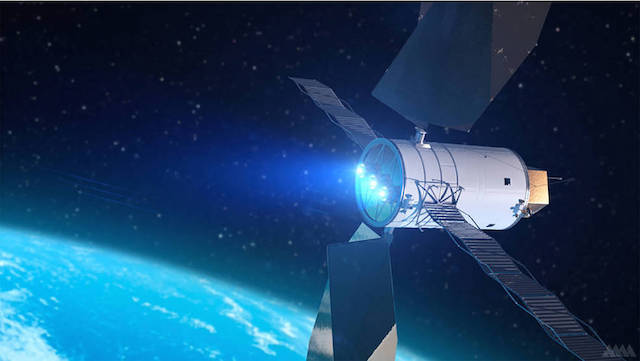From Battlestar Galactica to the imperial Death Star, the world of fiction is rife with gargantuan spacecraft capable of supporting thousands of residents with their own personal quarters and facilities.
But for real astronauts, spaceflight is not quite so, well, spacious. Take the International Space Station (ISS), which is the largest spacefaring vessel ever built, as well as the most expensive single construction project in human history, costing the US alone around $100 billion. Its first module was launched in November 1998, and its first long-duration crew, consisting of three people, arrived onboard two years later.
Videos by VICE
With an internal pressurized volume of 32,898 cubic feet, roughly equal to the interior of a Boeing 747, the ISS is a far cry from the cavernous starships we’re used to seeing in science fiction and fantasy. That said, the station and its predecessors are enormously helpful testbeds in the quest to develop even more massive spaceships down the line. Like the Mir space station, which flew from 1986 to 2001, the modules of the ISS were launched separately and assembled in space, like some high-stakes orbital LEGO kit.
Animation depicting assembly sequence of ISS. Video: NASA Johnson/YouTube
The cost of blasting separate components out of Earth’s powerful gravitational grasp is exorbitant, but the microgravity environment into which they are deployed offers considerable advantages for large engineering projects. What better place to construct colossal architectures than outer space, where immensely heavy structures are rendered functionally weightless and easily maneuverable by smaller spacecraft, or human astronauts? Indeed, anyone who has toyed around with the Kerbal Space Program is probably already familiar with the benefits of in situ orbital manufacturing.
Of course, there’s a big difference between throwing together spacecraft in a computer game, and assembling them in real life. Fortunately, the global space community has been steadily working towards achieving the centuries-old dream of big off-Earth structures that can support both robotic and human spaceflight missions.
Just last month, for instance, NASA announced its finalists for the Breakthrough, Innovative and Game-changing (BIG) Idea Challenge, which annually solicits concepts for emerging spaceflight platforms. In 2017, the BIG Challenge is focusing on designing modular spacecraft, powered by solar electric propulsion, that could ferry cargo from low Earth orbit to lunar distant retrograde orbit (LDRO).

Concept art of potential BIG idea design. Image: Analytical Mechanics Associates
According to Keith Belvin, the principal technologist for structures, materials and nanotechnology at NASA’s Space Technology Mission Directorate—and a judge for the BIG Challenge—LDRO is a particularly useful place to park and assemble large spacecraft because it has a much weaker gravity well relative to low Earth orbit.
“LDRO is about a 6,000 kilometer orbit [around the Moon],” Belvin told me over the phone. “It’s really nice for a lot of reasons. It’s pretty easy to access. It’s pretty easy to leave from. So, that could form a good staging location. If we developed a satellite assembly construction in situ manufacturing servicing capability in this orbit, then we could launch vehicles in pieces, and assemble them in that orbit.”
LDRO could even function as a service and refueling checkpoint for spacecraft returning from distant locations around the solar system. “Let’s suppose that we go to Phobos [one of Mars’ two moons] or do a Mars-type mission,” Belvin said. “When the vehicle comes back, instead of coming back to Earth and burning up, we would bring it back to LDRO, refurbish it, and use it again for another mission.”
The ability to reuse spacecraft in this way would drastically reduce the cost of robotic deep space exploration, while also spurring the kind of infrastructures crucial for human exploration to more distant worlds like Mars. It will take an enormous amount of money, time, and effort to build these orbital truck-stops, but the back-end payoff of paving a super-roadway in space would be well worth it, according to author and spaceflight advocate Howard Bloom.
“Why move NASA into space highway construction?” Bloom asked in a recent Scientific American article. “Because no one else will do it. And our future in space depends on it. Our future share in a space economy that United Launch Alliance (a joint venture rocket company from Boeing and Lockheed Martin) estimates will be worth $2.7 trillion in 30 years.”
This notion of building cumulatively larger, more robust, and more efficient modular structures in space could lay the groundwork for the kinds of futuristic space communities we’ve grown accustomed to seeing in fiction—like O’Neill cylinders or city-sized starships—even if that process takes decades, or even centuries.

O’Neill cylinder concept design. Image: Rick Guidice/NASA Ames Research Center
In the meantime, there are plenty of other massive spacecraft concepts aimed towards solving problems on our own planet. One of the most prominent is the longstanding dream of building solar power plants in space, where sunlight is abundant and unfiltered by atmospheric interference. Over time, researchers have produced numerous captivating concept designs for space-based solar arrays measuring a kilometer across, or more. These systems could deliver green energy to locations all around the world, while also powering orbital systems or deep space missions.
There are many hurdles left to clear before this lofty goal can be accomplished, but scientists, including Belvin, think space-based solar power is a technically sound possibility over the near term.
“I think the technology is almost there,” Belvin told me. “There’s a lot of engineering that has to take place to make it efficient and cost-effective. But I think of the Apollo Program, starting in the early 1960s, and that had to be a dream, to go to the Moon. If there’s the money, and the will, you can do a lot in a decade. So, if anybody says: ‘Hey, we’ve got to have an orbiting power system,’ for whatever reason, I think we could do it within a decade.”
READ MORE: Everything We Know About Beaming Solar Power to Earth from Space
It’s exciting to know that the space sector is beginning to close in on these ambitious projects, constrained mainly by funding and resources rather than the technology itself. And while it’s tricky to predict what kind of vessel will overtake the ISS as the largest spacefaring structure in history, the fact that there are so many potential candidates in the works right now is a cause for celebration.
Get six of our favorite Motherboard stories every day by signing up for our newsletter.




